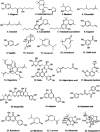Phytoconstituents Targeting the Serotonin 5-HT3 Receptor: Promising Therapeutic Strategies for Neurological Disorders
- PMID: 38898946
- PMCID: PMC11184608
- DOI: 10.1021/acsptsci.4c00084
Phytoconstituents Targeting the Serotonin 5-HT3 Receptor: Promising Therapeutic Strategies for Neurological Disorders
Abstract
The 5-hydroxytryptamine-3 receptor (5-HT3R), a subtype of serotonin receptor, is a ligand-gated ion channel crucial in mediating fast synaptic transmission in the central and peripheral nervous systems. This receptor significantly influences various neurological activities, encompassing neurotransmission, mood regulation, and cognitive processing; hence, it may serve as an innovative target for neurological disorders. Multiple studies have revealed promising results regarding the beneficial effects of these phytoconstituents and extracts on conditions such as nausea, vomiting, neuropathic pain depression, anxiety, Alzheimer's disease, cognition, epilepsy, sleep, and dyskinesia via modulation of 5-HT3R in the pathophysiology of neurological disorder. The review delves into a detailed exploration of in silico, in vitro, and in vivo studies and clinical studies that discussed phytoconstituents acting on 5-HT3R and attenuates difficulties in neurological diseases. The diverse mechanisms by which plant-derived phytoconstituents influence 5-HT3R activity offer exciting avenues for developing innovative therapeutic interventions. Besides producing an agonistic or antagonistic effect, some phytoconstituents exert modulatory effects on 5-HT3R activity through multifaceted mechanisms. These include γ-aminobutyric acid and cholinergic neuronal pathways, interactions with neurokinin (NK)-1, NK2, serotonergic, and γ-aminobutyric acid(GABA)ergic systems, dopaminergic influences, and mediation of calcium ions release and inflammatory cascades. Notably, the phytoconstituent's capacity to reduce oxidative stress has also emerged as a significant factor contributing to their modulatory role. Despite the promising implications, there is currently a dearth of exploration needed to understand the effect of phytochemicals on the 5-HT3R. Comprehensive preclinical and clinical research is of the utmost importance to broaden our knowledge of the potential therapeutic benefits associated with these substances.
© 2024 American Chemical Society.
Conflict of interest statement
The authors declare no competing financial interest.
Figures
Similar articles
-
Role of 5-hydroxytryptamine type 3 receptors in the regulation of anxiety reactions.J Zhejiang Univ Sci B. 2024 Jan 15;25(1):23-37. doi: 10.1631/jzus.B2200642. J Zhejiang Univ Sci B. 2024. PMID: 38163664 Free PMC article.
-
5-HT3 receptor antagonism a potential therapeutic approach for the treatment of depression and other disorders.Curr Neuropharmacol. 2021;19(9):1545-1559. doi: 10.2174/1570159X18666201015155816. Curr Neuropharmacol. 2021. PMID: 33059577 Free PMC article.
-
Structure, Function and Physiology of 5-Hydroxytryptamine Receptors Subtype 3.Subcell Biochem. 2021;96:373-408. doi: 10.1007/978-3-030-58971-4_11. Subcell Biochem. 2021. PMID: 33252737 Review.
-
Vortioxetine Subchronically Activates Serotonergic Transmission via Desensitization of Serotonin 5-HT1A Receptor with 5-HT3 Receptor Inhibition in Rats.Int J Mol Sci. 2019 Dec 10;20(24):6235. doi: 10.3390/ijms20246235. Int J Mol Sci. 2019. PMID: 31835640 Free PMC article.
-
The 5-HT3 receptor is present in different subpopulations of GABAergic neurons in the rat telencephalon.J Neurosci. 1997 May 1;17(9):3157-67. doi: 10.1523/JNEUROSCI.17-09-03157.1997. J Neurosci. 1997. PMID: 9096150 Free PMC article.
Cited by
-
Gut Microbiota Mediates Neuroinflammation in Alzheimer's Disease: Unraveling Key Factors and Mechanistic Insights.Mol Neurobiol. 2025 Mar;62(3):3746-3763. doi: 10.1007/s12035-024-04513-w. Epub 2024 Sep 25. Mol Neurobiol. 2025. PMID: 39317889 Review.
-
Semisynthetic phytochemicals in cancer treatment: a medicinal chemistry perspective.RSC Med Chem. 2024 Aug 7;15(10):3345-3370. doi: 10.1039/d4md00317a. eCollection 2024 Oct 17. RSC Med Chem. 2024. PMID: 39430100 Free PMC article. Review.
-
Medicinal Plants for Chemotherapy-Induced Nausea and Vomiting: A Systematic Review of Antiemetic, Chemosensitizing, and Immunomodulatory Mechanisms.Ther Clin Risk Manag. 2025 Jul 31;21:1187-1218. doi: 10.2147/TCRM.S531645. eCollection 2025. Ther Clin Risk Manag. 2025. PMID: 40771488 Free PMC article. Review.
References
Publication types
LinkOut - more resources
Full Text Sources



